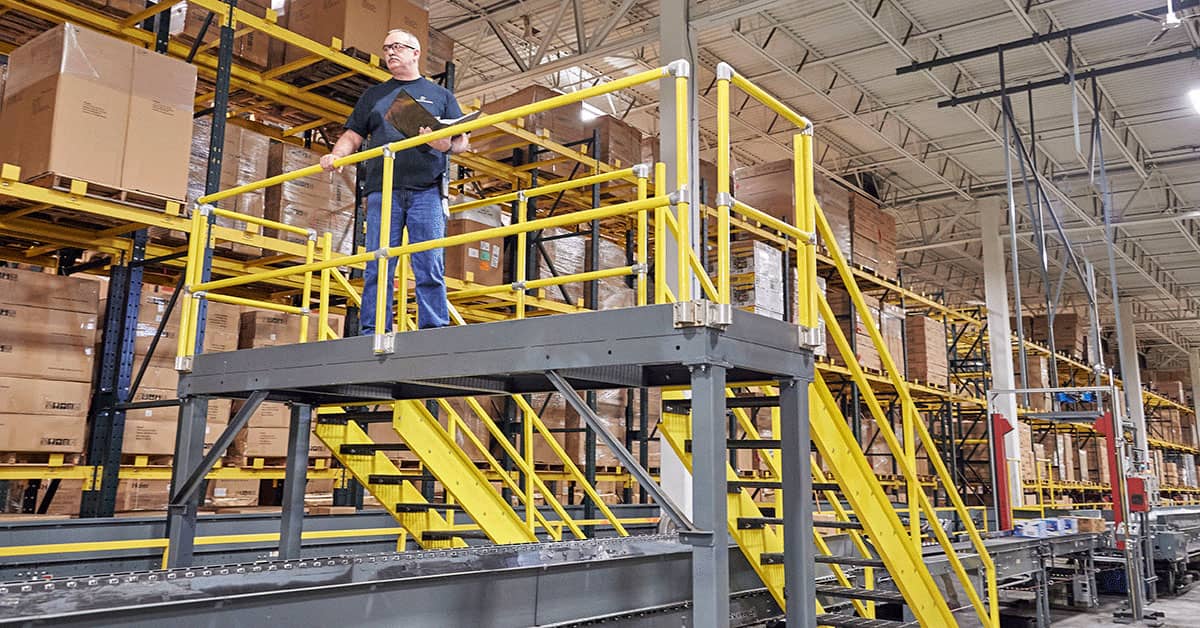Fall protection on docks and platforms
Date Posted: 10/24/2022

The Walking-Working Surfaces regulations define unprotected sides and edges to include any side or edge with no wall, guardrail system, or stair rail system to protect an employee from falling to a lower level. A common example is a loading dock when the door is open without a trailer in place.
Technically, edges or platforms less than four feet above a lower level do not require fall protection. Of course, a fall of less than four feet could cause a serious injury, so employers may want to provide a railing or other protection anyway.
Docks
A typical loading dock is just over four feet high, so if the dock door is open for ventilation, employers must provide fall protection such as a guardrail system. This could be a structure that swings or folds out of the way for loading or unloading. However, employers could use chains or ropes across the opening, if the result meets the requirements for a guardrail system under 1910.29(b). Among other things, those criteria require:
- A top rail at 42 inches, plus or minus three inches, capable of withstanding 200 pounds;
- A midrail capable of withstanding 150 pounds; and
- A minimum material diameter of 1/4 inch.
The regulation at 1910.29(b)(15) requires that ropes “used for top rails or midrails” be inspected as necessary to ensure that they continue to meet the strength requirements. Clearly, OSHA allows using ropes as guardrail components.
However, since a midrail is required, a single rope or chain across a dock opening is not sufficient, but two or more chains could suffice. Also, rope or chain used for the top rail cannot sag below 39 inches. Top rails must be 42 inches, plus or minus three inches, so the allowable range is 39 to 45 inches. If the rope stretches or sags below 39 inches, it would not meet the height requirement.
Platforms
OSHA defines a platform to include equipment operator platforms or other working surfaces. Any platform four feet or more above a lower level requires fall protection. Where guardrails aren’t practical, employers may use other methods such as personal fall protection systems.
Another issue is how employees access the platform. For frequently used platforms, employers should provide stairs. The regulation at 1910.25(b)(7) requires employers to ensure that “Standard stairs are used to provide access from one walking-working surface to another when operations necessitate regular and routine travel between levels, including access to operating platforms for equipment.”
OSHA allows a maximum stair riser height of 9.5 inches, but does not explicitly require that platforms above 9.5 inches include stairs. Still, if a platform is 10 inches or more and employees routinely access the platform, OSHA could potentially cite 1910.25(b)(7) if the employer didn’t provide stairs or steps.
How Safety Management Suite Can Help
OSHA requires employers to provide training on the proper care, inspection, storage, and use of equipment covered by the walking-working surface regulations. The agency doesn’t require general training, but delivering such training can reduce accidents. The Training area of the J. J. Keller® SAFETY MANAGEMENT SUITE can help, with courses on many topics to help you inform workers using online courses, classroom materials, and many other assets.
E-mail Newsletter
Sign up to receive the weekly EHS Insider email newsletter for safety articles, news headlines, regulatory alerts, industry events, webcasts, and more.